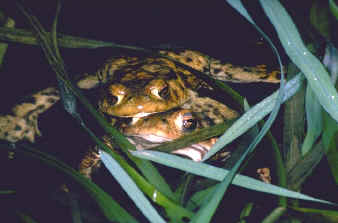Tadpole to Frog
The Amphibian Life Cycle
The metamorphosis
images link is at the bottom of the page
|
In a freshwater pond, a male toad claims a female by clasping onto her with his front feet. This will enable him to fertilize the jelly-like eggs immediately the female lays them into the water. |
| Amphibians are cold blooded vertebrates that spend
part of their lives on dry land and part in fresh water. Amphibian species present
in Britain include the Smooth Newt, Common Frog and the Common Toad. Many amphibians
must return to water in order to reproduce. It is this part of their life cycle
that many people are familiar with. During the U.K.'s spring months of February and
March, many fresh water ponds are occupied by one or more species of amphibian. Each
male will try and claim a female. Those males who are successful will fertilize up
to four thousand eggs as the female lays them into the shallower water, often within
clumps of aquatic plants. The fertilized eggs are just the first stage in a remarkable transformation called metamorphosis. This describes the process of change from egg to tadpole (the larval stage), through to adult amphibian. Many of the eggs which are laid will hatch into tiny tadpoles with dark, oval bodies and a waving tail which propels them through the water. At this stage, they do not resemble the parents in any way and only a small proportion of the tadpoles will ever reach adulthood. Many will be eaten by other creatures or die of disease. At first the tadpoles eat the remaining egg gel from which they hatched. They then eat submerged vegetable matter whilst absorbing oxygen directly from the water using their gills (fish also use gills to extract oxygen from the water). As they grow in size, lungs will develop inside the tadpoles and they will then begin to visit the surface in order to breathe in some of their oxygen from the air. Eventually the diet becomes more carnivorous as the tadpole will start eating small invertebrates in the water. As their bodies continue to grow, legs will sprout out and in frogs and toads the tail will be reduced in size. From now on, the tadpoles will become more adult like as time passes. Eventually the gills will disappear and the body changes shape into that of a miniature adult. Frog and toad tadpoles will lose their tails all together. At this stage they normally leave the water. In Britain, most of these changes take place during a 4-5 month period so that by August each year, many British amphibians have completed their development from egg to tiny adult. Some ponds become home to many thousands of toads and frogs in spring time when mating takes place. One such location is at the Woodland Education Centre, situated in East Devon, South West England. On only a few nights, visitors to the reserve are treated to a natural spectacle of vision and sound. Thousands of mating toads can be heard and seen within the Centre's ponds and lake. More information on amphibians here
|
Tadpole to Frog - Amphibian Metamorphosis in pictures |
